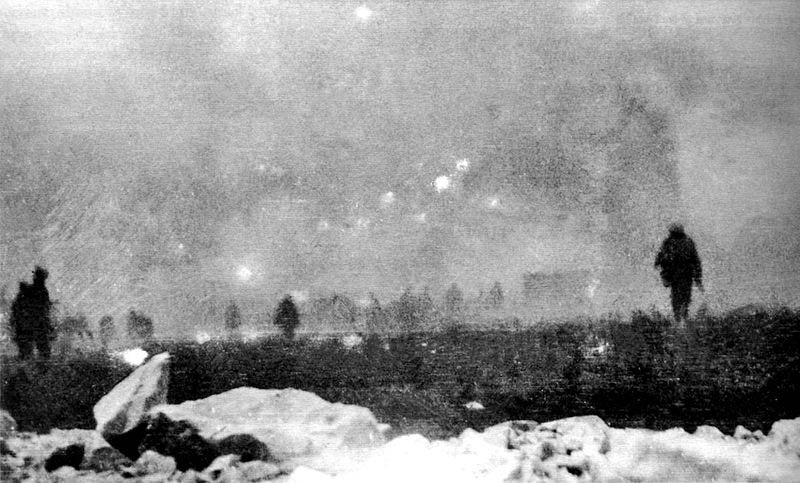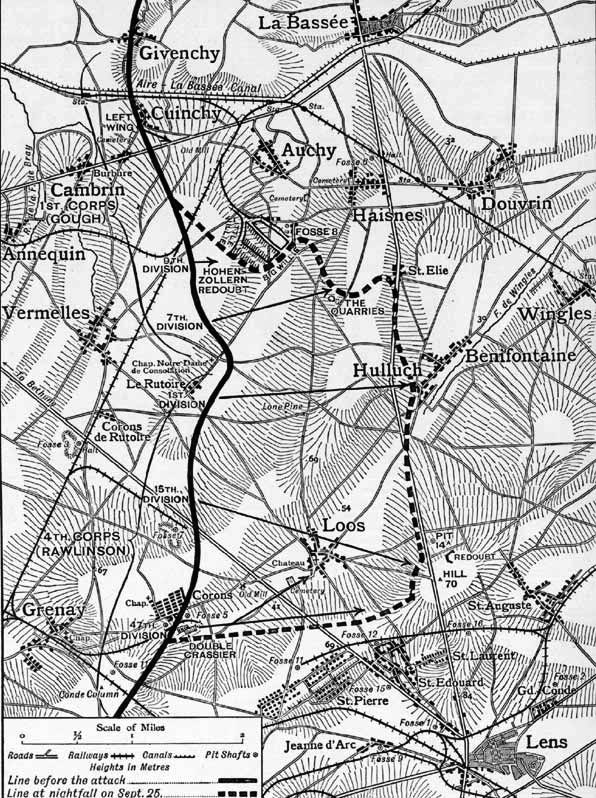| Battle of Loos | |||||||
|---|---|---|---|---|---|---|---|
 |
|||||||
|
|||||||
| Contenders | |||||||
| Unit Strength | |||||||
| 6 divisions | 3 divisions | ||||||
| Casualties and Deaths | |||||||
| Total: | Total: | ||||||
| 59,247 | 26,000 | ||||||
| Part of the World War I | |||||||
During the First World War, the Battle of Loos was the largest offensive mounted on the Western Front in 1915. This was the first time the British used poison gas and the battle was the very first engagement of New Army units.
Prelude to Battle
This battle marked the third use of the specialist Royal Engineer tunneling companies, who used underground mines to disrupt the enemy defense lines. This was done by using tunnels and detonating large explosives at zero hour. Sir John decided to keep a strong reserve that consisted of the Indian Cavalry Corps, Cavalry Corps, and Haking’s XI Corps (consisting of Guards Division and two New Army Divisions).
The Deputy CIGS, Murray, advised the French that fresh troops direct from training were better suited for long marches of an exploitation rather than trench warfare. The French were very doubtful that a breakthrough would be possible. Haig wanted the reserves close at hand to be able to exploit a breakthrough on the first day. The French agreed to deploy them closer to the front although they still thought they should be committed on the second day.
Using Chemical Warfare
Haig’s plans were quite limited by a shortage of artillery ammunition. This meant that the preliminary bombardment was very weak. About 150 tons of chlorine gas was released prior to the British attack. The contemporary gas masks used by soldiers were very inefficient and many soldiers removed them.
This meant that the British soldiers were affected by their own gas. The French wanted to be closer to the battle and so they moved to a forward command post at Lilliers, less than 20 miles behind the First Army’s front. Haig left most of his staff behind at GHQ. His infantry attacked at 6:30 a.m. on September 25th.
Details of the Battle
 The Battle of Loos opened on September 25th. In many areas, the British artillery had not succeeded in cutting the German wire in advance of the attack. While advancing over open fields within the range of German artillery and guns, the British suffered heavy losses.
The Battle of Loos opened on September 25th. In many areas, the British artillery had not succeeded in cutting the German wire in advance of the attack. While advancing over open fields within the range of German artillery and guns, the British suffered heavy losses.
However, due to numerical superiority, the British were finally able to break through the weak German defenses and capture the town of Loos. Communication problems, late arrival of reserves, and the inevitable end of their supply meant that the breakthrough could not be exploited. At around 11:00 a.m., the French visited Haig and agreed that he could have the reserve. At 1:20 p.m., Haig heard from Haking that the reserves were moving forward.
The German Efforts
The battle resumed the following day and the Germans were very prepared and held back any attempts to continue the opposing side’s advance. All the reserves were committed against the strengthened German positions. The 12 attacking battalions suffered 8,000 casualties out of 10,000 men in just four hours. On September 28th, the fighting subsided with the British having retreated to their starting positions. Their attacks had resulted to more than 20,000 casualties, including three divisional commanders.
After the initial attacks by British, the Germans made several attempts to recapture Hohenzollern Redoubt. They succeeded on October 3rd. On October 8th, Germans tried to recapture much of the lost ground. They were able to disrupt the British attack preparations and therefore caused a delay until October 13th. The final attack from the British was on October 13th, but this failed due to lack of grenades.
Casualties at Loos
During the Battle of Loos, the British casualties in main attack were 48,367 and 10,880 in subsidiary attack. The German casualties were about 51,100 men.